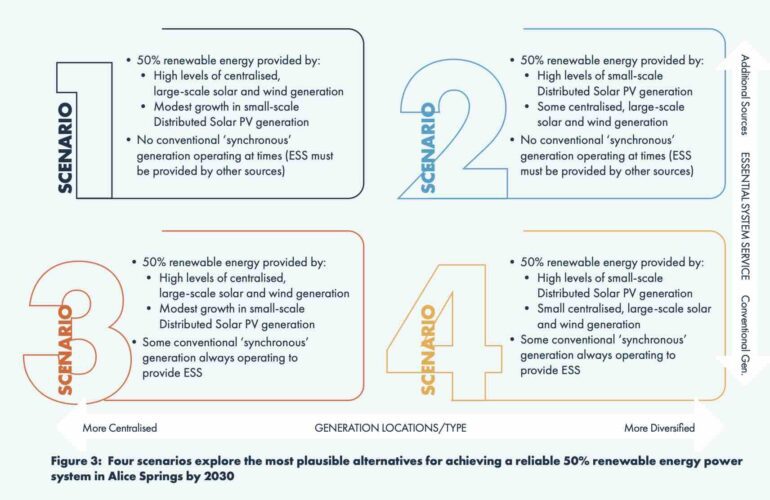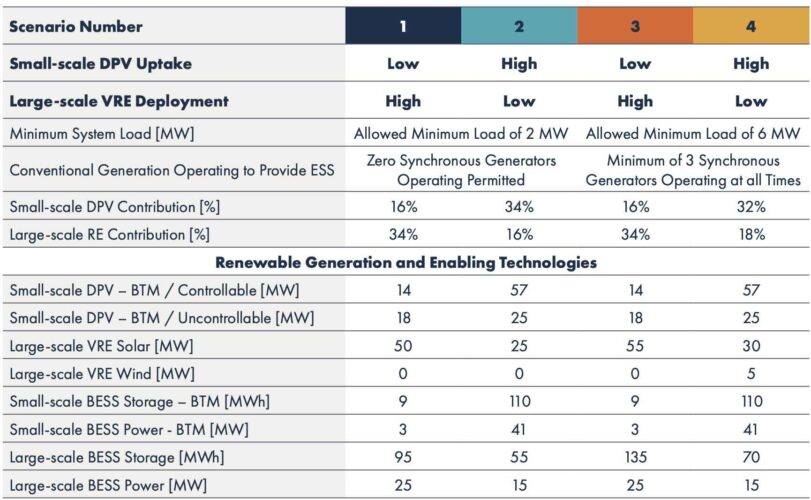Alice Springs is near the very centre of Australia: An iconic town made famous by its isolation, people, and multiple books and movies, and which now finds itself at the forefront of how to transition large isolated grids from fossil fuels to renewable energy.
Smaller towns and mines with bigger load centres have already made bigger leaps down the path to a grid dominated by renewables, but the complexity of a town like Alice is deepened by its size, isolation and the sheer number of individual consumers – more than 26,500 residents – and regulatory barriers.
Already, the town has found itself the focus of attention and unwanted headlines following a series of blackouts – initially blamed on renewables, but finally sheeted home to human error and equipment failures – that cost the jobs of the two most senior energy executives in the Northern Territory.
Now, a potential roadmap – dubbed the Alice Springs Future Grid – has been released after three years of work led by the locally-based Intyalheme Centre for Future Energy, in a project supported by the territory government and the Australian Renewable Energy Agency.
Its conclusions could be significant for how the switch to renewables is handled in the rest of the country, including in the largest grid, the National Electricity Market.
Alice Springs has had a relatively high take-up of rooftop solar – one quarter of all homes – and is host to what was once (in 2012) the largest ground mounted solar facility in the southern hemisphere, the 3.8 MW Uterne solar plant.

The town’s overall share of renewables, however, is still just 12 per cent, but it has already created a huge “solar duck” curve on sunny days (and most of them are) that hollows out grid demand in the middle of the day, putting the existing fossil fuel generators and system management under stress.
What makes this case really interesting – and different from other isolated grids – is that Alice Springs, because of its relatively big population, is a highly regulated grid, with a regulator, a market operator, a network provider and multiple retailers.
In effect, it’s a mini NEM, and because of that lessons it learns could be significant for the success of the country’s overall transition, which is facing its own deepening duck curve, and what to do with gigawatts of “legacy” rooftop solar that is barely visible and hard to control.
The Alice Springs Future Grid maps out four potential pathways to reach 50 per cent by 2030 – with a varying amount of rooftop and utility scale solar, household and grid scale battery storage, and potentially a little bit of wind.

But it’s not really about the technology issues or the technology mix – significant though they are they. The roadmap authors say it’s just as much about the “system” and how to manage the competing regulatory issues that is the key to success.
“Other grids have been able to progress further and faster than ours, but Alice Springs is a bigger challenge because there is not a single entity running the whole thing,” Lyndon Frearson, the project director of the Alice Springs Future Grid, and managing director of Ekistica,” tells RenewEconomy.
“It’s the regulatory framework that has become the constraint to earlier change. It’s a system issue, and it’s a lesson for the NEM.
“Some people say that Alice Springs doesn’t matter, but when you start implementing change, and dealing with the infrastructure of legacy systems such as rooftop PV, it is significant, particularly when you are dealing with gigawatts of legacy rooftop PV in the NEM.
“So much time is spent on trying to predict the future and arguing about the future, you end up missing the opportunities to do the things you need to do today to get there.
“So we have come up with what our plausible futures. And people will discuss those, and push some scenarios over others. But there are a lot of common decisions that you have to make now – you won’t reach any of those if you don’t start now,” he says.
Alice Springs currently features 122 MW of gas and diesel generators at the Owen Springs and the older Ron Goodwin facilities, the 3.8 MW Uterne solar facility, and 23 MW of rooftop solar, in a grid with peak demand of 50 MW, minimum demand of less than 6 MW, and declining average grid consumption of around 200 gigawatt hours.
The four technology scenarios mapped out by the Future grid project canvass different levels of solar, storage and wind.
The big swing factors are the level of control over rooftop PV, through advanced inverter technology, and whether the grid is designed so that it can run without any gas or diesel when solar is meeting all local demand in the middle of the day, or whether to keep a few synchronous generators running in the background.
Ironically, having the fossil fuel generators running at those times requires more storage because they would be needed to soak up more excess solar. The report also identifies the need for more automation, because the system is getting too complex for any human to manage.

“The Alice Springs system is arguably closest to the extremity of conventional power system capability due to the combination of high levels of DPV, increasing operational demand risks and the isolated nature of the system,” the report says.
“It is moving from a centralised, linear and one-directional past to a vastly more variable and bi-directional future that experiences almost ‘tidal’ operating characteristics.
“Managing such a system will require entirely new levels of dynamic interoperability between what were traditionally called the supply and demand sides of the system, including the need to orchestrate entirely new sources of system flexibility and ESS (energy storage) located both up and downstream.
“Unsurprisingly, such a complex and dynamic system means that conventional ‘human-in-the-loop’ control mechanisms become inadequate for managing its security and stability.
Addressing these challenges will require near-real time automation, upgraded protection systems and the consideration of targeted system architecture changes.
“While less visible than the more tangible elements of a renewable grid, such as wind turbines or energy storage systems, addressing these challenges is a key part of the opportunity for global leadership.”

Jimmy Cocking, the head of Desert Knowledge Australia, says the roadmap makes it clear that the system has to change, and that this will only happen through collaboration.
“The challenges we are facing as we move towards our goal of 50% renewable energy by 2030 are system challenges, and any solutions need to be system solutions,” Cocking says.
“This is a real opportunity for Alice Springs to come together, build momentum and continue to demonstrate our place as global leaders in this field.”










